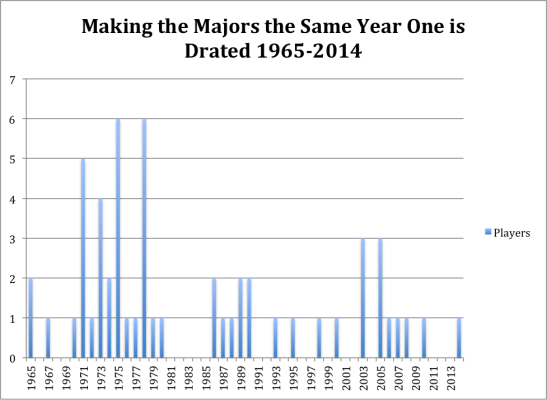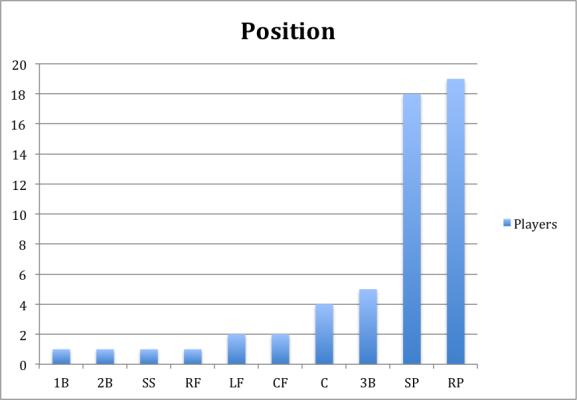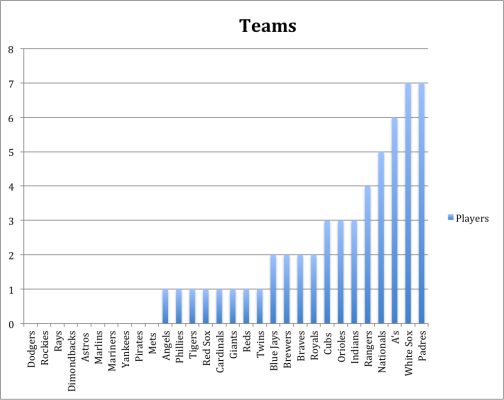The MLB season is nearing the one-quarter mark. Most teams are getting close to 40 games played and many starting pitchers have between 40 and 60 innings under their belts. With that in mind, I decided to take a look at fantasy-relevant starting pitchers. Fantasy-relevant can mean different things to different people, depending on the size of the league. For these purposes, I gathered information on all starting pitchers with four or more starts, then eliminated those who are projected by the FanGraphs Depth Charts to finish with an ERA over 4.25. This is arbitrary, I know, but I wanted to get the number of pitchers down to a smaller number. I was left with 90 pitchers.
Here is the key for the tables below:
IP—Current innings pitched (as of May 18)
ERA—Current ERA
FIP—Current FIP
xFIP—Current xFIP
DC-ERA—Rest-of-Season Projected Depth Charts ERA
ERA-xFIP—Current ERA minus current xFIP
ERA-DCERA—Current ERA minus Rest-of-Season Projected Depth Charts ERA
I used xFIP because I’ve read that it is a better predictor going forward than actual ERA or FIP.
I’ve separated the table into groups because a 90-pitcher spreadsheet just seems like too much to take in at one time. The groups will be sorted based on the difference between the pitcher’s current ERA and their current xFIP. With most of these pitchers having pitched around 50 innings, a difference of one earned run allowed is a difference of 0.18 in ERA, so I’ve used 0.54 and 1.08 as cutoff points in either direction for the charts.
The first group of pitchers includes those with an ERA at least 1.08 below their xFIP. These are the guys whose results are much better than you’d expect based on their peripherals.
The column on the far right shows the difference between their current xFIP and their Depth Charts RoS projections (DC-ERA). For pitchers who have a number close to zero, you could say they are pitching about as well as they’re projected to pitch going forward.
I will revisit these charts at the end of the year to see how things play out.

All of the pitchers in the top 17 have shown much better results than would be expected based on their peripherals and their projections. The column on the far right is interesting, though, and may be where we learn something at the end of the season. For example, Zack Greinke has a terrific 1.52 ERA, much lower than his 3.64 xFIP or his 3.20 FIP. His RoS Projection calls for a 3.14 ERA. At the end of the year, I will compare Greinke’s actual ERA from May 19th to the end of the season with these numbers. Greinke can be expected to have a higher ERA moving forward. The question is whether it will be closer to the 3.64 xFIP he has or the 3.14 DC-ERA.
A similar situation is true for Garrett Richards. Among this group of pitchers, Richards has the biggest difference between his xFIP and Depth Charts RoS projection (DC-ERA), at 0.69. Richards has a 2.29 ERA, 3.10 FIP, 4.04 xFIP, and 3.35 DC-ERA. He’s due for regression no matter which metric you favor, but is he closer to a 4.00 guy or a 3.30 guy?
A.J. Burnett has the biggest difference going the other direction, with a 3.58 xFIP and 3.98 DC-ERA. His current 1.38 ERA is ridiculous. He can be a useful pitcher with a 3.50-ish ERA but much less useful if his ERA is closer to 4.00 from this point on. Similar to Burnett is Dallas Keuchel, with a 1.87 ERA, 2.85 FIP, 3.28 xFIP, and 3.67 DC-ERA, and Jake Odorizzi (2.36 ERA, 2.49 FIP, 3.54 xFIP, 3.83 DC-ERA).
In theory (it’s my theory and I admit I am no Isaac Newton), the pitchers with the biggest negative difference in the column on the far right are pitchers who are more likely to beat their projections going forward. A big difference in the other direction could mean they are less likely to hit that projection. Again, I’ll revisit this at the end of the season.

This next group of pitchers also has results that are better than expected. The guy to target in this group based on my theory from above would be JA Happ:
JA Happ—2.98 ERA, 3.35 FIP, 3.58 xFIP, 4.07 DC-ERA. Happ is expected to regress but his FIP and xFIP say he won’t regress nearly as much as his projection would have you believe. In his first seven starts, Happ has a 1.8 BB/9, which is a much better walk rate than he’s had in any previous season of his career. His lifetime BB/9 is 3.7.
On the other hand, the following guys may not be all you want them to be:
John Lackey—2.96 ERA, 3.19 FIP, 4.00 xFIP, 3.63 DC-ERA. Lackey is striking out fewer batters and walking more than he did last year but has a much better ERA. The big difference has been a .269 BABIP and 0.4 HR/9. Last year he gave up 1.1 HR/9 and had a .305 BABIP. His xFIP suggests an ERA around 4.00 while his projection is for a 3.63 ERA going forward.
Jordan Zimmermann—3.66 ERA, 3.19 FIP, 4.21 xFIP, 3.32 DC-ERA. Zimmermann’s strikeout rate has dropped from 8.2 K/9 last year to 5.8 K/9 this year. That being said, last year looks like the outlier, as it was the first time in his first four years as a starter that his K/9 was over 7.1. Still, this year’s strikeout rate would be the lowest of Zimmermann’s career. His xFIP is at 4.21, while his rest-of-season projection is a much more optimistic 3.32.

These pitchers have ERAs within -0.54 and +0.54 of their xFIPs, which is the equivalent of two or three runs, so they could be considered the big group in the middle with numbers closest to what you’d expect. Still, the column to the right reveals some pitchers to target and avoid.
Guys who could outpitch their rest-of-season projections:
Gerrit Cole—2.40 ERA, 2.43 FIP, 2.75 xFIP, 3.32 DC-ERA. Cole could be taking a great leap forward to Ace status. He’s upped his strikeout rate and lowered his walk rate and his ERA, FIP, and xFIP are all below 3.00.
Jason Hammel—3.11 ERA, 3.36 FIP, 3.37 xFIP, 3.83 DC-ERA. Hammel is enjoying life back in the National League. In his career, Hammel has a 2.9 BB/9. Last year he sported a 1.9 BB/9 in his time with the Cubs but that went up to 2.8 BB/9 with the Athletics. He’s back with the Cubs and has walked just 1.2 per nine so far this year.
Chris Archer—2.47 ERA, 2.58 FIP, 2.73 xFIP, 3.47 DC-ERA. Through nine starts, Archer has jacked up his strikeout rate from last year’s 8.0 K/9 to 10.2 K/9. He’s also dropped his walk rate (3.3 BB/9 to 2.6 BB/9). He could be taking the leap along with Gerrit Cole to becoming a top tier-starting pitcher.
Jake Arrieta—2.77 ERA, 2.23 FIP, 2.69 xFIP, 3.39 DC-ERA. In his first four years in the major leagues (2010-2013), Jake Arrieta had a 5.23 ERA (4.75 FIP). Last year he broke out with the Cubs and posted a 2.53 ERA (2.26 FIP, 2.73 xFIP). Projections naturally expected some regression but he has been just as good this year as last year (2.23 FIP, 2.69 xFIP) so his Depth Charts Rest-of-Season Projection of 3.39 looks like it could be much too high.
Bartolo Colon—3.86 ERA, 3.60 FIP, 3.39 xFIP, 3.96 DC-ERA. Bartolo Colon saw what Phil Hughes did last year (186 strikeouts and 16 walks in 209 2/3 innings) and decided he would show the youngster how it’s done. Colon has 42 strikeouts and just one walk in 52 1/3 innings so far this year (he walked Ryan Zimmerman in his first outing this year, back on April 6th).
Guys to be cautious about:
Doug Fister—4.31 ERA, 4.71 FIP, 4.69 xFIP, 3.75 DC-ERA. Fister just went on the DL with forearm tightness so there’s a chance we won’t learn much from him over the rest of the season.
Madison Bumgarner—3.20 ERA, 3.52 FIP, 3.58 xFIP, 2.94 DC-ERA. Bumgarner pitched almost 270 innings last year when you include his stellar postseason and has seen his K/9 drop from 9.1 to 8.2 through his first eight starts. He can still be a positive contributor with an ERA in the 3.50 range but owners likely drafted him expecting an ERA near 3.00.
Alex Wood—3.83 ERA, 3.36 FIP, 4.02 xFIP, 3.49 DC-ERA. After striking out 8.9 batters per nine over his first 249 innings in the big leagues (2013 and 2014 combined), Wood’s K/9 has dropped to 6.1 this year. He’s upped his ground ball rate to over 50% but his fantasy owners would prefer he find those lost strikeouts.
Julio Teheran—4.33 ERA, 5.55 FIP, 4.18 xFIP, 3.66 DC-ERA. If you’re expecting Teheran to have a 3.66 ERA going forward, as his Depth Charts projection would suggest, you may be quite disappointed. Tehran is walking more batters than he ever has and giving up home runs at a ridiculous rate. Even adjusting to a league average home run rate doesn’t make him look very good, as his xFIP is over 4.00.

These pitchers all have ERAs that are worse than would be expected based on their xFIPs.
Guy from this group my theory would expect to be better than his rest-of-season projection:
Michael Pineda—3.31 ERA, 2.01 FIP, 2.41 xFIP, 3.27 DC-ERA. Pineda’s rookie year was back in 2011, when he struck out 9.1 batters per nine and walked 2.9. After missing two years because of injury, he came back last year to strike out 7.0 batters per nine and dropped his walk rate to 0.8 BB/9. This year, he has combined the best of both years, upping his strikeout rate to 9.6 K/9 and dropping his walk rate to 0.5 BB/9. He’s first in all of baseball with a 2.01 FIP and third in xFIP, at 2.41. Pineda’s rest-of-season projection calls for a 3.27 ERA but it looks like he could be on track to outdo that.
Guy my theory would not expect to be better than his rest-of-season projection:
Danny Duffy—5.87 ERA, 4.58 FIP, 4.82 xFIP, 3.86 DC-ERA. Duffy was a useful starting pitcher in fantasy league’s last year when he had a 2.53 ERA and 1.11 WHIP. His walk rate of 3.2 BB/9 was the best of his career. This year, he can’t get the walks under control (4.5 BB/9) and his ERA and WHIP have skyrocketed. Duffy’s FIP and xFIP don’t portend the improvement you might expect if you’re looking hopefully at his rest-of-season projection.

This final group of pitchers includes guys who have ERAs much worse than their xFIPs. These are the guys who have destroyed you ratios in the early going. You probably aren’t real happy with any of these chumps. Based on regression to the mean, they should all be better, but you knew that. Which guys should REALLY be better and which guys should you be a bit more skeptical about?
Should be MUCH better:
Danny Salazar—4.06 ERA, 3.52 FIP, 2.36 xFIP, 3.55 DC-ERA. Since returning from his minor league exile to start the season, Salazar has struck out 12.4 batters per nine and walked just 1.4. He’s given up too many home runs (7 in 37 2/3 innings, 1.7 HR/9), which has inflated his ERA. Salazar’s rest-of-season projection calls for an ERA around 3.50, which is the same as his current FIP. His xFIP, though, has him with an ERA under 2.50.
Clay Buchholz—4.93 ERA, 2.91 FIP, 2.99 xFIP, 3.95 DC-ERA. Based on the things a pitcher has the most control over—strikeouts, walks, and home runs allowed—Clay Buchholz is having his best season (10.6 K/9, 2.6 BB/9, 0.8 HR/9). Based on actual results (2-4 record, 4.93 ERA, 1.38 WHIP), he’s been pretty bad. He should be better. The caveat with Buchholz is that his ERA last year was 5.34, which was much higher than his FIP (4.01) and xFIP (4.04), so you just don’t know if maybe this is who he is now. For the record, in his career, Buchholz has a 3.97 ERA, 4.00 FIP, and 4.03 xFIP.
Finally, the guys who should be better but maybe not as good as you hope:
Chris Tillman—6.34 ERA, 5.42 FIP, 5.09 xFIP, 4.24 DC-ERA. From 2012-2014, Chris Tillman had a 3.42 ERA and 1.19 WHIP in 499 2/3 innings, although his FIP was a much less impressive 4.22. This year, Tillman currently has a 6.34 ERA through seven starts and his FIP and xFIP are both over 5.00. He’s projected to have a 4.24 ERA from this point forward but a sky-high walk rate (4.5 BB/9) will have to come down for him to approach that number.
Stephen Strasburg—5.98 ERA, 3.47 FIP, 3.66 xFIP, 3.14 DC-ERA. It’s shocking to see Stephen Strasburg with a 5.98 ERA. He’s striking out fewer batters than last year (9.3 K/9 to 10.1 K/9) and walking more (2.7 BB/9 TO 1.8 BB/9), but his strikeout and walk numbers are still quite good. The biggest problem appears to be a .389 BABIP and 60.6 LOB%. The Depth Chart projections expect a 3.14 ERA going forward but Strasburg’s FIP (3.47) and xFIP (3.66) aren’t as optimistic.










